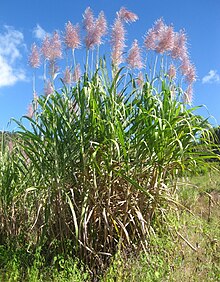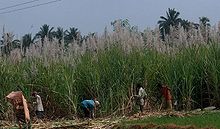
Sorghum or broomcorn is a genus of about 25 species of flowering plants in the grass family (Poaceae). Some of these species are grown as cereals for human consumption, in pastures for animals as fodder, and as bristles for brooms. Sorghum grain is a nutritious food rich in protein, dietary fiber, B vitamins, and minerals.

Saccharum is a genus of tall perennial plants of the broomsedge tribe within the grass family.
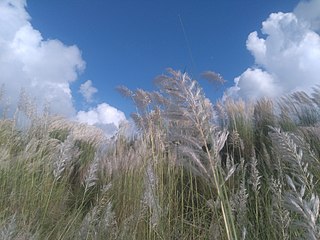
Saccharum spontaneum is a grass native throughout much of tropical and subtropical Asia, northern Australia, and eastern and northern Africa.. It is a perennial grass, growing up to three meters in height, with spreading rhizomatous roots.
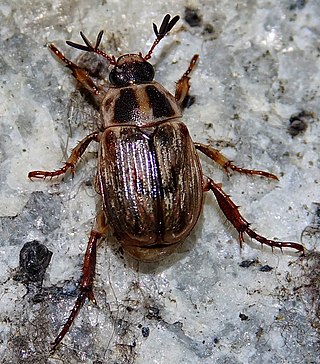
Exomala orientalis, also known as the oriental beetle (OB), is a species of Rutelinae in the family Scarabaeidae. It is a beetle about 0.7 - 1.1 cm long, with mottled, metallic brown- and black-colored elytra and a similarly colored thorax and head during the adult stage. It is sometimes confused with the larger and more colorful Japanese beetle. During the larval stage, the oriental beetle can be identified by the parallel line raster pattern.

Sorghum bicolor, commonly called sorghum and also known as great millet, broomcorn, guinea corn, durra, imphee, jowar, or milo, is a grass species cultivated for its grain, which is used for food for humans, animal feed, and ethanol production. Sorghum originated in Africa, and is now cultivated widely in tropical and subtropical regions. Sorghum is the world's fifth-most important cereal crop after rice, wheat, maize, and barley, with 61,000,000 metric tons of annual global production in 2021. S. bicolor is typically an annual, but some cultivars are perennial. It grows in clumps that may reach over 4 metres (13 ft) high. The grain is small, ranging from 2 to 4 millimetres in diameter. Sweet sorghums are sorghum cultivars that are primarily grown for forage, syrup production, and ethanol; they are taller than those grown for grain.

Leptosphaeria sacchari is a plant pathogenic fungus which causes a disease called ring spot on Saccharum officinarum. This species was originally described in 1890 by Kruger and in 1892 by Van Breda de Haan after it was discovered in the Dominican Republic. L. sacchari is the applied name, whereas Epicoccum sorghinum is the accepted name.

Puccinia melanocephala is a fungus and plant pathogen, it is the causal agent of sugarcane rust. It was originally found on the leaves of a species of Arundinaria (cane) in Assam, India.

Sugarcane or sugar cane is a species of tall, perennial grass that is used for sugar production. The plants are 2–6 m (6–20 ft) tall with stout, jointed, fibrous stalks that are rich in sucrose, which accumulates in the stalk internodes. Sugarcanes belong to the grass family, Poaceae, an economically important flowering plant family that includes maize, wheat, rice, and sorghum, and many forage crops. It is native to the warm temperate and tropical regions of India, Southeast Asia, and New Guinea.
Eumetopina flavipes, the island sugarcane planthopper, is a species of planthopper present throughout South East Asia. E. flavipes is a vector for Ramu stunt disease, a plant disease which affects sugarcane. Ramu stunt disease is widespread throughout Papua New Guinea, but has not been detected in Australia.

The history of sugar has five main phases:
- The extraction of sugar cane juice from the sugarcane plant, and the subsequent domestication of the plant in tropical India and Southeast Asia sometime around 4,000 BC.
- The invention of manufacture of cane sugar granules from sugarcane juice in India a little over two thousand years ago, followed by improvements in refining the crystal granules in India in the early centuries AD.
- The spread of cultivation and manufacture of cane sugar to the medieval Islamic world together with some improvements in production methods.
- The spread of cultivation and manufacture of cane sugar to the West Indies and tropical parts of the Americas beginning in the 16th century, followed by more intensive improvements in production in the 17th through 19th centuries in that part of the world.
- The development of beet sugar, high-fructose corn syrup and other sweeteners in the 19th and 20th centuries.
Edward Leonard Caum (1893–1952) was a United States botanist known for his work on plant species in Hawaii.

Sugarcane grassy shoot disease (SCGS), is associated with 'Candidatus Phytoplasma sacchari' which are small, pleomorphic, pathogenic mycoplasma that contribute to yield losses from 5% up to 20% in sugarcane. These losses are higher in the ratoon crop. A higher incidence of SCGS has been recorded in some parts of Southeast Asia and India, resulting in 100% loss in cane yield and sugar production.
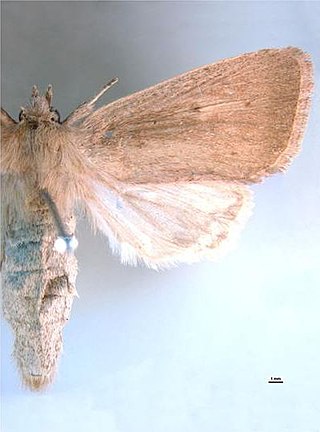
Sesamia grisescens, the pink sugarcane borer, pink stalk borer, shoot borer, sugarcane borer or ramu shoot borer, is a moth of the family Noctuidae. The species was first described by Warren in 1911. It is found in Papua New Guinea, Seram, the Moluccas and New Britain.
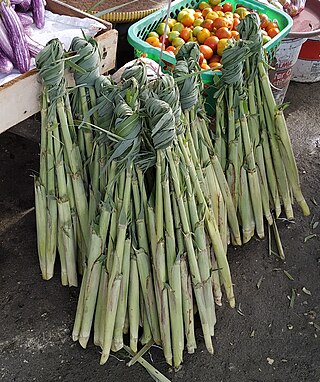
Saccharum edule is a species of sugarcane, that is a grass in the genus Saccharum with a fibrous stalk that is rich in sugar. It is cultivated in tropical climates in southeastern Asia. It has many common names which include duruka, tebu telor, PNG/Fiji asparagus, dule (Fiji), pitpit and naviso.

Sugarcane Breeding Institute (SBI) is a central research institute in Coimbatore, India. It was established in 1912 and is affiliated to Indian Council of Agricultural Research. It was established to promote research efforts in sugarcane production and is the only sugarcane research institute in the country.

Charles Alfred Barber C.I.E. was a British botanist and specialist on sugarcane, who worked for much of his life in southern India. Saccharum barberi, a species of sugarcane that grows wild in northern India is named after him. He was a pioneer in the nobilization of wild canes in India, by producing hybrids between wild and hardy local species and the high-sugar-yielding cultivated Saccharum officinarum that could survive the cold winters of northern India.
Rao BahadurSir Tiruvadi Sambasiva Iyer Venkataraman CIE, FNI, FASc was an Indian botanist, agronomist and plant geneticist who specialised in the study and hybridisation of sugarcane. He developed or supervised the development of numerous high-yield sugarcane cultivars, which established India as the world's second largest sugar producer and sustained the sugar industries of numerous other nations, including South Africa, Australia, Bangladesh, Indonesia, Pakistan, and the United States.

Saccharum sinense or Saccharum × sinense, synonym Saccharum × barberi, sugarcane, is strong-growing species of grass (Poaceae) in the genus Saccharum. It is originally cultivated in Guangzhou, China where it is still commonly grown. It is a more primitive form of sugarcane with a hybrid origin from Saccharum officinarum and Saccharum spontaneum species of cane. A number of clones exists that are often included in the S. officinarum species as the Pansahi group. The most notable member of which is the Uba variety of cane. They are a perennial plant that grows in erect clumps that can reach up to 5 meters in height and have a red cane with a diameter of 15 mm to 30 mm.

One of the major human migration events was the maritime settlement of the islands of the Indo-Pacific by the Austronesian peoples, believed to have started from at least 5,500 to 4,000 BP. These migrations were accompanied by a set of domesticated, semi-domesticated, and commensal plants and animals transported via outrigger ships and catamarans that enabled early Austronesians to thrive in the islands of Maritime Southeast Asia, Near Oceania (Melanesia), Remote Oceania, Madagascar, and the Comoros Islands.
Sugarcane sereh disease was a disease of sugarcane reported from Indonesia in the 19th century Dutch colonial plantations. It has been suggested that it was caused by a phytoplasma or a virus. The name sereh disease is derived from the resemblance of infected cane to lemon grass which is known as sereh. Gerharda Wilbrink discovered that heat treatment of the planting material at 45°C for half an hour made the material disease free.
